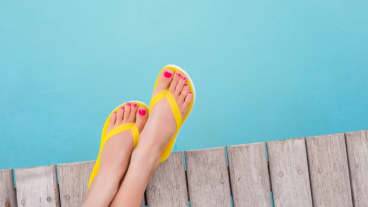 Sculptra®
Sculptra®Is Foot Filler Really A Thing?
The short answer is yes – and it actually has the ability to treat quite a bit.
We’ve heard of lip filler, cheek filler, and even hand filler, but it wasn’t until recently that the notion of foot filler crossed our desks. Just because it may not enjoy the same notoriety, however, does not mean it lacks a fan base. “A fair number of people do it,” says Darren Smith, MD, a board certified plastic and reconstructive surgeon in New York City. “It just doesn’t come up in conversation.”
To change that, we spoke to two physicians familiar with foot injections — which, keep in mind, isn’t necessarily all dermatologists or plastic surgeons — to learn more about the benefits of injecting filler into the feet for both cosmetic and functional benefits.
The Aesthetic Benefits of Foot Filler
Dermal fillers can be used to shape features from head to toe – quite literally. The same fillers you put in your face to restore lost volume and contour can be injected into your feet for both cosmetic and functional purposes, Dr. Smith says.
If aesthetics are your concern, you’re likely going to be treating the tops of the feet. “Loss of volume in many different parts of the body connotes aging, and the feet are no different,” Dr. Smith explains. “Some people think their veins are too visible or their tendons are too visible.” While this is a natural part of the aging process for many, it can also be exacerbated by certain otherwise healthy lifestyle habits. It’s fairly common for people who work out regularly to lose fat on their feet (sadly, your running regimen doesn’t just make you choose between your ass and your face), which can make tendons appear more visible over time.
Similar to using filler to rejuvenate aging hands, injecting hyaluronic acid (HA)-based fillers, such as Juvéderm® or Belotero®, into the top of the foot can camouflage bulging veins or tendons and add volume. As with most HA filler injections, the results last six to nine months before it’s time for a touch up.
The Functional Benefits of Foot Filler
Sure, cosmetic foot filler can be a confidence-booster for those of us who are insecure about our feet. But the real game-changing use of injectables is functional. Neil Sadick, MD, a board certified cosmetic dermatologist in NYC and the founder of Stride, recommends foot filler for patients — typically ones who’ve been referred by a podiatrist — who have pain when they walk. Think of the filler as an in-sole that you just so happen to be inserting into your own foot.
For patients who come to Dr. Sadick with plantar fasciitis, calluses around the foot, or thickening of the heels, filler can act as a cushion to the area and lead to less mechanical trauma from the regular act of walking on two feet. Dr. Smith agrees. “If you look at a cross section of a foot, you should have a nice little pillow of fat at the soul of your forefoot and the soul of your hind foot,” he shares. “There are people with genetic reasons or repetitive use reasons — some people think if you spend a lot of time walking around barefoot, for example — where those fat pads, which should serve as shock absorbers, atrophy or shrink over time.”
In such cases, it becomes very painful to walk, and that’s where your injector can come in and help you recreate the natural cushion that has been lost. HA fillers can be employed for this purpose (studies show HA filler injections under the metatarsal heads can provide a “significant and long-lasting improvement” in treating metatarsalgia – a condition in which the ball of the foot becomes painful and inflamed – caused by wearing high heels), Dr. Smith likes biostimulatory injectables, like Radiesse® and Sculptra®, for functional improvement. The former is made of calcium hydroxylapatite (CAHA) and the latter of poly-L-lactic acid (PLLA), which both stimulate natural collagen production in the body for a longer-term effect.
Depending on the patient, fat grafting may also be an option. Dr. Smith says he works closely with podiatrists to address functional foot issues with fat transfer, which involves liposuctioning fat from a donor site (think: the flanks or thighs), purifying it, and injecting it into the feet. After an initial reabsorption period, the transferred fat is permanent.
The Takeaway
The feet may not be the flashiest place to inject filler, but strategic placement of HA and biostimulatory injectables can be transformative for those who experience certain kinds of foot pain or those with aesthetic concerns about their trotters. If you’re interested in foot filler, start with a visit to a board certified cosmetic dermatologist or plastic surgeon who has experience injecting in this area. “There’s lots of important stuff in the foot,” Dr. Smith cautions. A slip of the needle could lead to nerve problems, blown veins, or damaged tendons, all issues a practiced injector will know how to avoid.
More Related Articles
Related Procedures

AI Plastic Surgeon™
powered by'Try on' aesthetic procedures and instantly visualize possible results with The AI Plastic Surgeon, our patented 3D aesthetic simulator.


